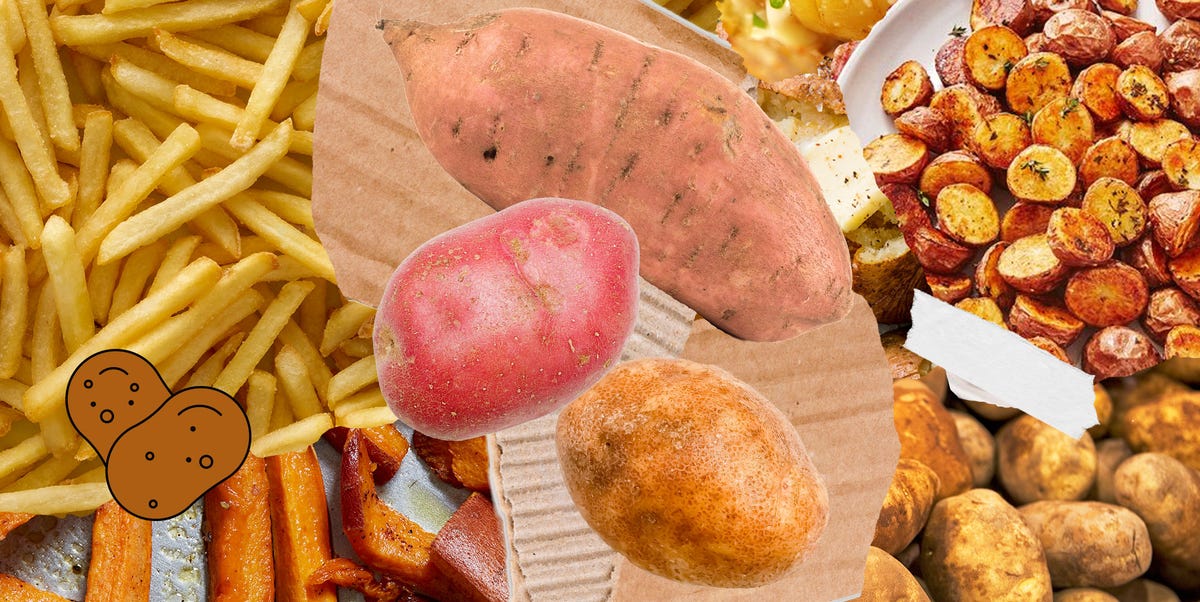
Is there a more versatile ingredient than the humble tuber we call potato? Since being spread from the Americas in the 16th century, potatoes in their many forms have grown to dominate culinary cultures across the globe. Potatoes are eaten mashed, fried, pureed, pickled, grilled, steamed, sautéed, dehydrated, and even just simply boiled. But for as many methods of preparations, there are even more types of potatoes. Potatoes come in all shapes, sizes and colors and each type can lend itself better to certain ways of cooking. In order to help you parse all these potato pedigrees we created this explainer that goes over some of the most common potatoes you might see in your local market.
Russet Potatoes
For many folks, especially in America, this is what you think of when you hear the word potato. Russets will usually have a tannish, brown skin that’s slightly rough to the touch. They can vary in size from that of a toddler’s fist to bigger than a guinea pig. Russet potatoes are famously starch and can sometimes border on mealy. This texture coupled with their density make them ideal for frying. The exterior of russet fries will absorb hot oil beautifully while allowing the interiors to essentially steam to become fluffy and airy.
Red Potatoes
These pretty boys are smaller than russets and have smooth exterior. The interior is typically paler than a standard russet and has almost a shiny finish. This smoothness and shininess are characteristics of the waxy family of potatoes. Waxy potatoes are known for being lower in starch and having a higher moisture content. This ratio means that red potatoes maintain their shape when cooked and hold up well to things like boiling, braising and stewing. We love to use red potatoes in something like a beef stew or potato salad, where the potato should retain its shape and a bit of toothy creaminess that will be a good canvas for other flavors.
Yukon Gold Potatoes
Yukon Golds are medium-sized potatoes that are known for their smooth skin and their 24K interior. In terms of texture, they fall into the middle group between starchy and waxy that is often referred to as “all-purpose” potatoes. Not surprisingly, they lend well to applications where either starchy or waxy potatoes might be used. Yukon Golds in particular are known for their natural creaminess and are thus our favorites for the most luscious potato dish of all: mashed potatoes. It truly feels like Yukon Gold’s were bred to be pulverized together with various forms of dairy into fluffy mashed potatoes where their subtle sweet, potato flavor and their innate creaminess can really be shown off.
Fingerling Potatoes
Not surprisingly, these adorable little potatoes are shaped like fat fingers and are typically found with a light tan, smooth skin. These, like the Reds, are waxy potatoes but because of their diminutive proportions they are perfect for roasting. You can simply cover them in olive oil, rosemary and salt and toss them in the oven. We do recommend you slice them in half and place them cut side down so you get some beautiful caramelization on them.
Baby, Young, Or New Potatoes
These potatoes actually aren’t their own type of potato at all, but instead just a younger version of existing potatoes like red, fingerlings, purple, etc. Since their harvested so early, their skins are thinner and more gentle than that of their matured counterparts. They are typically slightly sweeter than “old” potatoes and will actually go bad faster than matured potatoes. One of the best ways to prepare baby potatoes is to smash them! After they’ve been boiled, smooshed into a hot pan and lightly pan fried, they basically become potato popcorn.
Sweet Potatoes
We could have written an entirely separate piece on sweet potatoes and the various types you might find from the purple ube to the Japanese white sweet potato. But, the most popular variety in the states is the Beauregard, and they, like russets, can vary in size greatly. They have a rough orange-ish brown skin that gives way to bright orange flesh. Other than their inherent sweetness, sweet potatoes are also more nutritious than normal potatoes, packing lots of vitamin A, vitamin C and fiber. Sweet potatoes shouldn’t only be used in desserts or other explicitly sweet dishes, like the much debated casserole. We will often sub in sweet potatoes in recipes where we’d otherwise use any of the other potatoes mentioned above for a bit more complexity and subtle sweetness.
Yams
Though yams are often confused for sweet potatoes, they’re actually from a totally different plant family. But, much like sweet potatoes, there are too many types of yams to go into here. Many species of yam are often far larger than any potato. Case in point, it is not uncommon to find a yucca that is the size of your forearm. Yams often have a far thicker skin than potatoes and can be almost bark like. They also have a strach content that rivals (and in some casses surpasses) russets.
Well if you’ve gained anything from this, we hope its that you go run out now and pick up a bag of spuds and make something incredible. Maybe one of these 70+ potato recipes?
This content is created and maintained by a third party, and imported onto this page to help users provide their email addresses. You may be able to find more information about this and similar content at piano.io
May 28, 2021 at 02:27AM
https://ift.tt/2QXibuH
7 Potatoes You Need To Know About - Delish.com
https://ift.tt/2rh4zOj
Potato
No comments:
Post a Comment